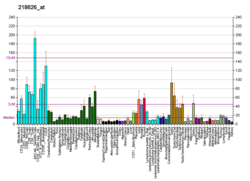EIF4ENIF1
Eukaryotic translation initiation factor 4E transporter is a protein that in humans is encoded by the EIF4ENIF1 gene.[5][6]
The protein encoded by this gene is a nucleocytoplasmic shuttle protein for the translation initiation factor eIF4E. This shuttle protein interacts with the importin alpha-beta complex to mediate nuclear import of eIF4E. It is predominantly cytoplasmic;its own nuclear import is regulated by a nuclear localization signal and nuclear export signals.[6]
Interactions
References
- 1 2 3 GRCh38: Ensembl release 89: ENSG00000184708 - Ensembl, May 2017
- 1 2 3 GRCm38: Ensembl release 89: ENSMUSG00000020454 - Ensembl, May 2017
- ↑ "Human PubMed Reference:".
- ↑ "Mouse PubMed Reference:".
- 1 2 Dostie J, Ferraiuolo M, Pause A, Adam SA, Sonenberg N (Aug 2000). "A novel shuttling protein, 4E-T, mediates the nuclear import of the mRNA 5' cap-binding protein, eIF4E". EMBO J. 19 (12): 3142–56. doi:10.1093/emboj/19.12.3142. PMC 203362. PMID 10856257.
- 1 2 "Entrez Gene: EIF4ENIF1 eukaryotic translation initiation factor 4E nuclear import factor 1".
Further reading
- Strausberg RL, Feingold EA, Grouse LH, et al. (2003). "Generation and initial analysis of more than 15,000 full-length human and mouse cDNA sequences". Proc. Natl. Acad. Sci. U.S.A. 99 (26): 16899–903. doi:10.1073/pnas.242603899. PMC 139241. PMID 12477932.
- Warner DR, Roberts EA, Greene RM, Pisano MM (2004). "Identification of novel Smad binding proteins". Biochem. Biophys. Res. Commun. 312 (4): 1185–90. doi:10.1016/j.bbrc.2003.11.049. PMID 14651998.
- Ota T, Suzuki Y, Nishikawa T, et al. (2004). "Complete sequencing and characterization of 21,243 full-length human cDNAs". Nat. Genet. 36 (1): 40–5. doi:10.1038/ng1285. PMID 14702039.
- Ballif BA, Villén J, Beausoleil SA, et al. (2005). "Phosphoproteomic analysis of the developing mouse brain". Mol. Cell. Proteomics. 3 (11): 1093–101. doi:10.1074/mcp.M400085-MCP200. PMID 15345747.
- Collins JE, Wright CL, Edwards CA, et al. (2005). "A genome annotation-driven approach to cloning the human ORFeome". Genome Biol. 5 (10): R84. doi:10.1186/gb-2004-5-10-r84. PMC 545604. PMID 15461802.
- Gerhard DS, Wagner L, Feingold EA, et al. (2004). "The status, quality, and expansion of the NIH full-length cDNA project: the Mammalian Gene Collection (MGC)". Genome Res. 14 (10B): 2121–7. doi:10.1101/gr.2596504. PMC 528928. PMID 15489334.
- Andrei MA, Ingelfinger D, Heintzmann R, et al. (2005). "A role for eIF4E and eIF4E-transporter in targeting mRNPs to mammalian processing bodies". RNA. 11 (5): 717–27. doi:10.1261/rna.2340405. PMC 1370757. PMID 15840819.
- Ferraiuolo MA, Basak S, Dostie J, et al. (2005). "A role for the eIF4E-binding protein 4E-T in P-body formation and mRNA decay". J. Cell Biol. 170 (6): 913–24. doi:10.1083/jcb.200504039. PMC 2171455. PMID 16157702.
- Rual JF, Venkatesan K, Hao T, et al. (2005). "Towards a proteome-scale map of the human protein-protein interaction network". Nature. 437 (7062): 1173–8. doi:10.1038/nature04209. PMID 16189514.
- Wichroski MJ, Robb GB, Rana TM (2006). "Human retroviral host restriction factors APOBEC3G and APOBEC3F localize to mRNA processing bodies". PLoS Pathog. 2 (5): e41. doi:10.1371/journal.ppat.0020041. PMC 1458959. PMID 16699599.
- Lim J, Hao T, Shaw C, et al. (2006). "A protein-protein interaction network for human inherited ataxias and disorders of Purkinje cell degeneration". Cell. 125 (4): 801–14. doi:10.1016/j.cell.2006.03.032. PMID 16713569.
- Denoeud F, Kapranov P, Ucla C, et al. (2007). "Prominent use of distal 5' transcription start sites and discovery of a large number of additional exons in ENCODE regions". Genome Res. 17 (6): 746–59. doi:10.1101/gr.5660607. PMC 1891335. PMID 17567994.
This article is issued from
Wikipedia.
The text is licensed under Creative Commons - Attribution - Sharealike.
Additional terms may apply for the media files.




